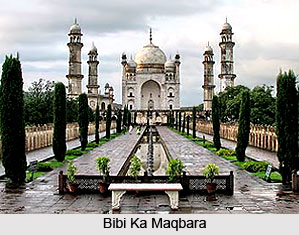 Bibi Ka Maqbara, situated in Aurangabad district of the Indian state Maharashtra, is a tomb built by the sixth Mughal Emperor Aurangzeb in the memory of his loving wife Dilras Banu Begum. She was posthumously known as Rabia-ud-Daurani. The tomb was structured in the 17th century and exhibits strong similarity with Taj Mahal which is the mausoleum of his mother Mumtaz Mahal. Architectural works of Aurangzeb did not gain prominence as he was not much interested in this arena. There are just a few monuments to his credit among which the small yet elegant Pearl Mosque located at Delhi is well known. Bibi Ka Maqbara is accredited as the largest and principle monument built by the emperor. It is an excellent testament of the architectural transition in Mughal dynasty from the architectural grandeur of Akbar and Shah Jahan to the simplicity of the later rulers.
Bibi Ka Maqbara, situated in Aurangabad district of the Indian state Maharashtra, is a tomb built by the sixth Mughal Emperor Aurangzeb in the memory of his loving wife Dilras Banu Begum. She was posthumously known as Rabia-ud-Daurani. The tomb was structured in the 17th century and exhibits strong similarity with Taj Mahal which is the mausoleum of his mother Mumtaz Mahal. Architectural works of Aurangzeb did not gain prominence as he was not much interested in this arena. There are just a few monuments to his credit among which the small yet elegant Pearl Mosque located at Delhi is well known. Bibi Ka Maqbara is accredited as the largest and principle monument built by the emperor. It is an excellent testament of the architectural transition in Mughal dynasty from the architectural grandeur of Akbar and Shah Jahan to the simplicity of the later rulers.
History of Bibi Ka Maqbara
Bibi ka Maqbara was erected in between the period of 1651 and 1661 C.E. "Tawarikh Namah" of Ghulam Mustafa states that Emperor Aurangzeb had allocated an amount of seven lakhs for its construction out of which six lakh sixty eight thousand two hundred and three and seven annas were spent. The marble which structures the mausoleum was brought from the mines located near Jaipur in Rajasthan. According to the accounts of Tavernier, a French gem merchant and traveller, about three hundred carts full of marbles were journeyed from Surat to Golconda.
Architecture of Bibi Ka Maqbara
Owing to the stark resemblance of Bibi Ka Maqbara with the famed monument Taj Mahal, it is also known as Dakkhani Taj which refers to Taj of the Deccan. It is believed that its constant comparison with Taj Mahal has greatly masked its own beauty. The main entrance door of the monument bears an inscription which states that the mausoleum was designed and constructed by Hanspat Rai and Ata-ullah an engineer and an architect respectively. Ata-ullah was the son of the principle architect of Taj Mahal, Ustad Ahmad Lahauri. Bibi Ka Maqbara exhibits an exquisite structure in which minarets adorn the corners. Simple yet charming artistic elements have been used to embellish the interior and exterior of the mausoleum. The tomb was intended to compete with Taj Mahal but the severe budgetary constraints on the part of Aurangzeb resulted in its poor architecture, lacking in structural proportions.



















